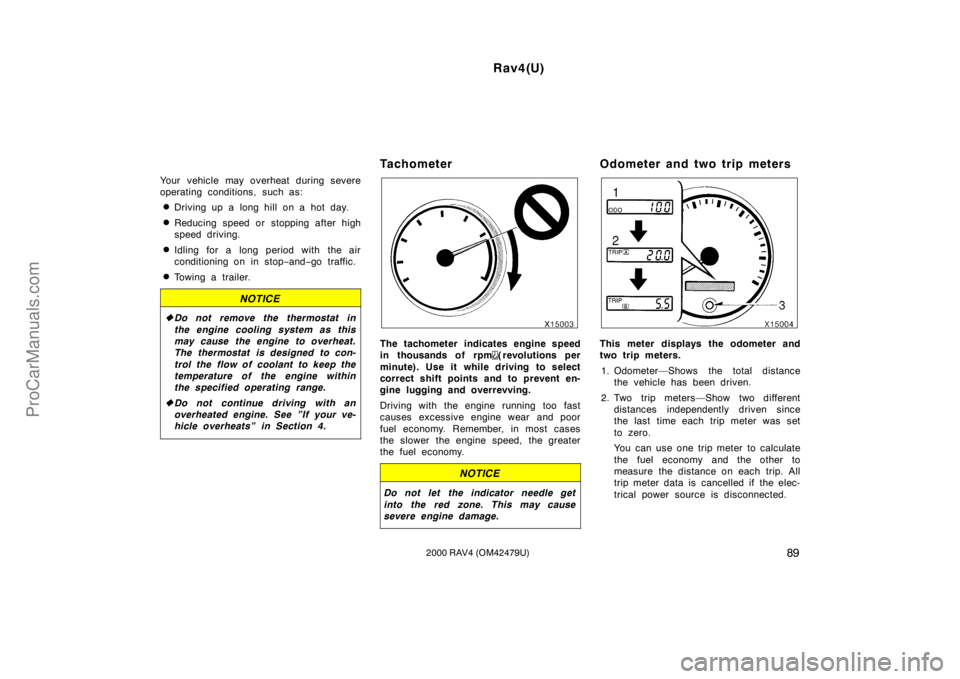Page 12 of 250
Rav4(U)
42000 RAV4 (OM42479U)
Instrument cluster overview
1. Speedometer
2. Fuel gauge
3. Service reminder indicators and
indicator lights4. Engine coolant temperature gauge
5. Tachometer
6. Trip meter reset knob7. Odometer and two trip meters
ProCarManuals.com
Page 95 of 250
Rav4(U)
872000 RAV4 (OM42479U)
OPERATION OF INSTRUMENTS AND
CONTROLS
Gauges, Meters and Service reminder indicators
Fuel gauge88 . . . . . . . . . . . . . . . . . . . . . . . . . . . . . . . . . . . . . . . . . . . . . . . . .
Engine coolant temperature gauge 88. . . . . . . . . . . . . . . . . . . . . . . . . . . . .
Tachometer89 . . . . . . . . . . . . . . . . . . . . . . . . . . . . . . . . . . . . . . . . . . . . . . . . .
Odometer and two trip meters89 . . . . . . . . . . . . . . . . . . . . . . . . . . . . . . . . .
Service reminder indicators and warning buzzers 90. . . . . . . . . . . . . . . .
SECTION 1− 5
ProCarManuals.com
Page 97 of 250

Rav4(U)
892000 RAV4 (OM42479U)
Your vehicle may overheat during severe
operating conditions, such as:
�Driving up a long hill on a hot day.
�Reducing speed or stopping after high
speed driving.
�Idling for a long period with the air
conditioning on in stop−and−go traffic.
�Towing a trailer.
NOTICE
�Do not remove the thermostat in
the engine cooling system as this
may cause the engine to overheat.
The thermostat is designed to con-
trol the flow of coolant to keep the
temperature of the engine within
the specified operating range.
�Do not continue driving with an
overheated engine. See ”If your ve-
hicle overheats” in Section 4.
Tachometer
The tachometer indicates engine speed
in thousands of rpm
( revolutions per
minute). Use it while driving to select
correct shift points and to prevent en-
gine lugging and overrevving.
Driving with the engine running too fast
causes excessive engine wear and poor
fuel economy. Remember, in most cases
the slower the engine speed, the greater
the fuel economy.
NOTICE
Do not let the indicator needle get
into the red zone. This may cause
severe engine damage.
Odometer and two trip meters
This meter displays the odometer and
two trip meters.
1. Odometer—Shows the total distance
the vehicle has been driven.
2. Two trip meters—Show two different
distances independently driven since
the last time each trip meter was set
to zero.
You can use one trip meter to calculate
the fuel economy and the other to
measure the distance on each trip. All
trip meter data is cancelled if the elec-
trical power source is disconnected.
ProCarManuals.com
Page 98 of 250
Rav4(U)
902000 RAV4 (OM42479U)
3. Trip meter reset knob—Resets the two
trip meters to zero, and also change
the meter display.
To change the meter display, quickly
push and release the knob. The meter
display changes in the order from the
odometer to trip meter A to trip meter
B, then back to the odometer each
time you push.
To reset the trip meter A to zero, dis-
play the meter A reading, then push
and hold the knob until the meter is
set to zero. The same process can be
applied for resetting the trip meter B.
(a) If parking brake
is off, stop
immediately and
contact Toyota
dealer.
(b) Fasten seat belt.If the indicator or
buzzer comes on...
(c) Stop and check.(indicator and buzzer)
(d) Stop and check.(type A)
(type B)
Do this.
(g) Take vehicle to
Toyota dealer.
(type A)
(type B) (f) Fill up tank. (e) Take vehicle to
Toyota dealer.
(type A)
(type B)
If the indicator or
buzzer comes on...Do this.
Service reminder indicators
an d warn in g bu zzers
ProCarManuals.com
Page 219 of 250

Rav4(U)
2112000 RAV4 (OM42479U)
�Be sure to reinstall the tire inflation
valve caps. Without the valve caps,
dirt or moisture could get into the valve
core and cause air leakage. If the caps
have been lost, have new ones put on
as soon as possible.
Checking and replacing tires
Tread wear indicator
CHECKING YOUR TIRES
Check the tire tread for the tread wear
indicators. If the indicators show, re-
place the tires.
The tires on your Toyota have built−in tread
wear indicators to help you know when the
tires need replacement. When the tread
depth wears to 1.6 mm (0.06 in.) or less,
the indicators will appear. If you can see
the indicators in two or more adjacent
grooves, the tire should be replaced. The
lower the tread, the higher the risk of skid-
ding.
The effectiveness of snow tires is lost
if the tread wears down below 4 mm
(0.16 in.).Check the tires regularly for damage
such as cuts, splits and cracks. If any
damage is found, consult with a techni-
cian and have the tire repaired or re-
placed.
Even if the damage does not appear serious,
a qualified technician should examine the
damage. Objects which have penetrated the
tire may have caused internal damage.
Any tires which are over 6 years old
must be checked by a qualified techni-
cian even if damage is not obvious.
Tires deteriorate with age even if they have
never or seldom been used.
This also applies to the spare tire and tires
stored for future use.
REPLACING YOUR TIRES
When replacing a tire, use only the
same size and construction as original-
ly installed and with the same or great-
er load capacity.
Using any other size or type of tire may seri-
ously affect handling, ride, speedometer/
odometer calibration, ground clearance, and
clearance between the body and tires or
snow chains.
ProCarManuals.com
Page 222 of 250

Rav4(U)
2142000 RAV4 (OM42479U)
NOTICE
If the wrong combination of tire and
chain is used, the chains could dam-
age the vehicle body.
∗ RAV4 genuine tire chains
(Part No. 08329−42801)
Laws about using tire chains vary ac-
cording to locality and type of road, so
always check your local laws before
you install tire chains.
CHAIN INSTALLATION
Four−wheel drive models:
Install the chains on the rear tires as
tightly as possible. Do not use tire
chains on the front tires. Retighten
chains after driving 0.5—1.0 km
(1/4—1/2 mile).
Tw o−wheel drive models:
Install the chains on the front tires as
tightly as possible. Do not use tire
chains on the rear tires. Retighten
chains after driving 0.5—1.0 km
(1/4—1/2 mile).When installing chains on your tires, care-
fully follow the instructions of the chain
manufacturer.
If wheel covers are used, they will be
scratched by the chain band, so remove the
covers before putting on the chains.
CAUTION
�Do not exceed 50 km/h (30 mph) or
the chain manufacturer ’s recom-
mended speed limit, whichever is
lower.
�Drive carefully avoiding bumps,
holes, and sharp turns, which may
cause the vehicle to bounce.
�Avoid sharp turns or locked−wheel
braking, as use of chains may ad-
versely affect vehicle handling.
Replacing wheels
WHEN TO REPLACE YOUR WHEELS
If you have wheel damage such as
bending, cracks or heavy corrosion, the
wheel should be replaced.
If you fail to replace damaged wheels, the
tire may slip off the wheel or cause loss
of handling control.
WHEEL SELECTION
When replacing wheels, care should be
taken to ensure that the wheels are re-
placed by ones with the same load ca-
pacity, diameter, rim width, and offset.
Correct replacement wheels are available at
your Toyota dealer.
A wheel of a different brand, size and type
may adversely affect handling, wheel and
bearing life, brake cooling, speedometer/
odometer calibration, stopping ability, head-
light aim, bumper height, vehicle ground
clearance, and tire or snow chain clearance
to the body and chassis.
ProCarManuals.com